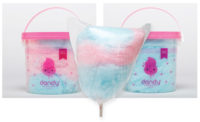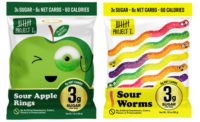“Flavor-iety” — if only it were a real word, because no other captures the essence of the gummies and jellies right now. Manufacturers are turning to innovative flavors and novel designs to capture the attention of both children and adult consumers.
For proof it’s working, look no further than the data. Gummy candy represents 26% of all consumption of chewy candy, leading the way in the chewy candy subcategory, along with taffy, licorice and fruit chews candies, according to a “Sweet Insights” report by the National Confectioners Association.
It might be no surprise that gummies are incredibly popular these days — the average American consumes chewy candy about 47 times each year — but the consumers most likely to grab a bag off the shelf aren’t who you think. A whopping 65% of chewy candy is actually consumed by adults, shows the report.
Rob Swaigen, vice president of marketing at Jelly Belly notes that the company is up about 25% in gummy sales, with gummy bears skewing more to an adult audience.
One of the main reasons behind the success of the industry is flavor. According to the NCA report, “I like the taste” was the top reason people claim to enjoy gummy candy in particular.
Consumers are especially looking for flavor intensity and strength.
“We have seen a trend towards intense, realistic flavors — candy foods that really burst with flavor,” says Kim Vollrath, director of sales and marketing at Gimbal’s Fine Candies.
Vollrath says the Gimbal’s product has especially implemented the trend toward realistic tastes in their sour cherry flavor, part of their new Sour Gourmet Jelly Bean line.
“This cherry tastes so real it’s like you’ve just picked it off a tree,” she says, contrasting it with the harsh artificial taste of a candy cherry or a cough syrup cherry.
Flavor combinations are also hot on the market this year, as companies are looking for more innovative ways to meet consumers’ demand for new tastes.
“Recently, we’ve seen new products that include interesting flavor combinations and unique shapes,” says Jennifer Jackson-Luth, senior manager of marketing communications at Wm. Wrigley Jr. Co.
Wrigley’s most recent gummy product, Life Savers Gummies Collisions, which launched in December 2011, is in keeping with this trend. The product is the first of the Life Savers Gummies variety to bring consumers two Life Savers flavors together in one bite, combining raspberry, watermelon, cherry, and pineapple flavors.
And, Starburst’s new Flavor Morph line from Wrigley, released in December 2011 as well, also offers a two-flavor experience. These treats “morph” from one to two juicy flavors as they are chewed.
Small beads in the product burst with a second flavor, creating a unique and interesting taste experience. The cherry flavor transforms into a cherry-lime combination, while the orange one turns into an orange-strawberry mix.
Another avenue manufacturers are exploring is using real fruit juice in their candies. For example, Jelly Belly is re-launching its Sunkist Fruit Gems line later this year, and the product is now made with all-natural ingredients and real fruit juice.
Swaigen notes that although many candy companies claim their products are made with real fruit juice, the juice they use for most of their fruit flavors often ends up being apple juice, regardless of the fruit flavor the candy is supposed to represent.
ThisFruit Gems line, however, uses authentic fruit juice for each corresponding flavor. For example, real blueberry juice is used in the blueberry Fruit Gems, further enhancing the flavor of the product. The candy is then sanded in sugar for a sweet finish.
Meanwhile, Gimbal’s newest product, the Sour Gourmet Jelly Bean line, has 12 flavors and is made with real fruit juice, making it a good source of vitamin C. In keeping with the new flavors trend, Gimbal’s is introducing sour mango and sour pomegranate as two taste varieties that have not been made in jelly bean format before.
Gimbal’s new jelly beans also include more traditional tastes like sour strawberry, sour apple, and sour lemon. However, Vollrath notes it’s important for manufacturers to ensure consumers come across new flavor experiences so they can remain competitive in the industry.
“People are looking for new and interesting flavors,” says Vollrath. “They’re sort of reaching out from the common well-known flavors. They still love those, but they want more.”
Novelty designs and innovative shapes also seem to be trending in the category. According to the NCA report, when consumers were asked for the second reason they enjoy gummy candy, their answer was short and simple, “It’s fun.”
Many times these products are marketed toward children.
For example, Jelly Belly will introduce their newest addition to their Jelly Belly Gummi Pet line, the Gummi Pet Cockroach, in June of this year. Each gummy is created with two different flavors — one for the legs of the “cockroach” and one for its body. The treat will be available in three combinations of flavors: blackberry and cherry, grape and lime, and orange and blackberry.
Characters from video games and movies also have come to life in gummy form, as more candy companies are releasing confections that reference pop culture. Some recent examples include Au’some’sSuper Mario 3-Dees Gummies and Healthy Food Brands’ Angry Birds.
Au’some, a wholly-owned subsidiary of Candy Novelty Works Limited, recently came out with their 3-Dees Gummies line, gummies shaped like movie and video game characters. The company uses unique machinery technology to create the intricate gummy shapes, allowing for very fine details to appear in the moulded gummy characters.
With gummy cockroaches and sour pomegranate jelly beans, it’s difficult to imagine what the future of the gummies and jellies industry holds. Although consumer tastes may change, some things will stay the same, remarks Swaigen.
“This idea of good, strong, intense flavors and interesting shapes isn’t going away,” says Swaigen. “It’s the backbone of this business.”
So it looks like strong flavors, taste varieties, and appearance novelties are here to stay. As for “flavor-iety” — if it ever catches on, we coined it here first.






